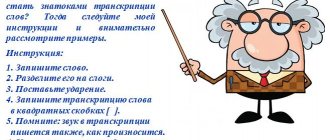Online speech therapy exercises
Speech therapy of vowels:
|
| | | | | | | | | Difficult vowels:
e;e;yu;ya |
e;u;e;y;a;o;e;ya;i;yu | Setting consonant sounds and letters:
|
| | | | | | | | | | | | | | | | | | | Difficult consonants:
b;p | w;w | z;s | g;k | s;ts | v;f | r;l | p;l | r;p;l | z;s;c | h;f;sh;sch;ts;x |
It is better to study often and in short portions than to arrange long lessons, but with long breaks. It is best if the classes take place simultaneously. For example, you go to kindergarten and learn to say a certain word. Or learn a song. Thanks to the site (), the child will learn to overcome speech disorders and build confidence in their abilities. In this section of the site, you will find classes on speech development intended for classes with children from 1 to 7 years old. In individual lessons with a speech therapist, work is carried out on the production of sounds and the development of phonemic perception.
Why do you have problems pronouncing sibilants?
Certain areas of the brain are responsible for the process of speech development. If their work is disrupted, difficulties arise with the pronunciation of individual sounds. In most cases, the problem is caused by birth injuries. Of particular danger are displacements of the skull bones of the occipital part or vertebrae. As a result, blood circulation in the head area slows down. Brain cells do not receive the required amount of oxygen, which leads to their destruction.
An injury received during childbirth can also provoke pinching of the hypoglossal nerve or disturbances in the associative neural connections of the auditory analyzer. This affects the ability to recognize and reproduce oral speech. For the correct pronunciation of individual sounds, the chewing and facial muscles are no less important. In some cases, speech development in children is slowed down due to injuries received after birth (falling from a sofa, hitting the back of the head, etc.).
conclusions
Dysarthria is not just a failure to pronounce certain sounds. And you certainly shouldn’t expect a child with such a diagnosis to “talk” like the neighbors’ daughter. This speech disorder is much deeper and more complex, but it is not always a death sentence. The main thing is not to waste time.
This is why turning a blind eye to the problem is a huge mistake as parents. Of course, it is difficult to accept the fact that your child has some kind of impairment. But this must be done precisely for the benefit of the future of your baby. An untreated disease will bring many problems to an adult in social life - from communication to work.
If the disease is detected at an early stage of development, it can be cured. An integrated approach to therapy gives good results. Of course, if there are no gross disorders of the nervous system.
It is even better if it was possible to diagnose the disease when it has not yet made itself felt, that is, before the baby’s first attempts to speak. Such early corrective work will become effective prevention.
How to teach a child to say the letter “sh”
Young children often have problems pronouncing hissing sounds. Doctors have identified several possible reasons for this phenomenon. The most common of these is incorrect articulation. It represents a certain position of the tongue during pronunciation. Other reasons include:
- Incorrect pronunciation of sounds by parents. The child pronounces them as he hears them from others.
- Limitation of motor activity of the tongue due to a shortened hyoid frenulum.
- Disturbances in the functioning of the hearing aid.
- Anomalies in the structure of the teeth and jaw.
Initially, the cause of a mechanical nature should be eliminated. If the problem is a short frenulum, it is trimmed. It is important to pay attention to your child's bite. In case of deviations, appropriate measures are taken. In other cases, a set of exercises helps to improve speech.
Staging from A, E, Y
If there is nothing in the asset, you can try to put it from the vowels, A, E, Y. Ask to pronounce them and use the probe to lift your tongue up. In general, Ш is placed well in the reverse syllables ASH - OSH - USH - YSH - ESH. Especially with severe speech disorders, when the baby does not speak at all, this is an option. In addition, we must not forget that with dysarthria, as a rule, C is placed last. Because tremor and hyperkinesis of the tongue make it impossible to achieve purity of sound without preliminary treatment with massage.
Diagnostics
Speech is formed between 3 and 5 years. If problems arise, parents need to take their child to a speech therapist. Diagnosis by a specialist is carried out in a playful way. The doctor determines which sounds the child has problems pronouncing. A visual examination of the articulatory apparatus is also carried out. This includes an examination of the oral cavity. The structure of the jaw, tooth, lips and palate are assessed. During the examination, the child is asked to do the following:
- attempts to reach the chin and nose with the tongue;
- moving the tongue from the left side of the mouth to the right, periodically changing the rhythm of movements;
- pushing the lower jaw forward and then back;
- clicking the tongue;
- the formation of a tube from the lips after they are stretched into a smile.
We train to navigate in space
- “Whose traces?” . Pictures with traces of hands and feet are needed. The baby must determine which arm or leg is right and which is left.
- "Supermarket" . The parent asks the child to arrange the goods: “on the shelf”, “near the cash register”, “to the right of the cookies”, “under the counter”.
- Counting sticks. Can be replaced with matches. The parent makes some figure out of them, and the baby makes a similar one according to the image.
This complex can also be performed at home.
How to check the pronunciation of hissing words without a speech therapist
To teach your child to pronounce hissing sounds, you need to set up the correct articulation. But an assessment of the speech apparatus is required first. It is not necessary to visit a speech therapist to identify gaps. This can also be done at home. It is necessary to have a conversation with the child, during which the movements of the baby’s lips and tongue are observed. Normally, when pronouncing the sound “sh” the following is observed:
- the tip of the tongue rises to the palate, forming a small gap;
- the air flow passes through the inactive vocal cords, causing the corresponding sound;
- the lips are pulled forward, forming a tube;
- the lateral edges of the tongue touch the upper teeth.
Possible deviations
Pronunciation may differ from ideal. Despite the fact that in the language “sh” is a dull sound, it must be pronounced loudly and clearly. There are speech therapy characteristics of the incorrect “sh”:
- A lisping sound occurs when a child pushes his tongue too far between his teeth. This is an interdental pronunciation.
- A nasal tint (sigmatism) in “sh” occurs when the deep part of the tongue is overly tense, its root seems to be pulled towards the palate, and a deep hissing “x” appears.
- With lateral sigmatism, the sound is like cotton.
- If the tongue rests on the upper incisors, this is called parasigmatism. As a result, “w” is replaced by “t”;
- With labiodental parasigmatism, “w” is forced to turn into “f”. It is worth checking if the baby has bite problems.
- If instead of "sh" the sound is "s", this is whistling parasigmatism.
You need to tell your child how to form his lips correctly and hold his tongue so that the sound comes out correctly. It is best to demonstrate on yourself and use visual analogies.
Training the correct pronunciation of hissing words
The production of the sound “sh” is carried out in stages. To achieve the desired results, you need to train constantly. The articulatory gymnastics complex includes exercises for each zone of the speech apparatus.
Warm up your tongue
Language training is especially important in establishing the correct pronunciation of sounds. Its position plays a significant role in the development of speech skills. The most effective exercises include:
- Having closed your teeth, you need to push your tongue through the resulting hole.
- You should smile with your mouth wide open, and then place the edge of your tongue on your lower lip. You need to hold this position for 40 seconds.
- With your mouth slightly open, you need to reach your tongue with your nose. This exercise is repeated at least 5 times.
- Starting position - as in the previous exercise. You need to cover the upper front teeth with your tongue, and then return it to its place.
- With your mouth wide open, you need to raise your tongue to your nose as much as possible, and then lower it to your chin.
- The tongue protrudes from the mouth, and a piece of candy is placed on its tip. The child should try to stick it to the palate directly behind the upper teeth.
Warm up our lips
Regular lip training will help you pronounce sounds correctly in the future. They need to be combined with exercises for other areas of the oral cavity:
- The most effective exercise is the “tube”. The teeth close tightly and the lips extend forward. They should not cover their teeth. You should hold this position for 6 seconds.
- Alternating “smile” and “pipe” exercises. You should smile with your mouth completely closed.
- It is necessary to stretch your lips, trying to round them. After 6 seconds you should return to the starting position.
- The “tube” exercise is first performed in the standard form. After this, the improvised tube should be made larger by slightly opening the lips.
Tongue massage
Speech therapy massage is considered one of the methods for correcting pronunciation. It not only promotes the correct production of sounds, but also accelerates the development of speech in general. Manual treatment reduces salivation and improves the tone of the facial muscles. For skin and colds, massage is contraindicated.
The duration of the first session is 10 minutes. The facial muscles are pre-relaxed. It is important to create favorable conditions so that the child is not distracted by anything. Over time, the duration of the procedure increases to 20-30 minutes. The course of treatment includes 15 visits to a specialist.
Sonora
This group includes “L”, “R” and their soft pairs. It is advisable to begin the correction with them, simultaneously working on the preparatory stage for the hissing ones. Often they are quickly processed.
There are three ways to set sound:
- mechanical - it requires probes or their substitutes;
- by imitation - not always possible;
- mixed - implies the use of both.
Producing the sound “R” with dysarthria is better done with a probe. Due to problems with the motor muscles, it will not be possible to call him by imitation. The probe looks like a smooth stick with a small ball at the end.
It is better to place the child on his back. He should relax. He is asked to open his mouth, place the tip of his tongue on the alveoli and pronounce the distorted sound “Z” (provided that it is in speech). At this moment, the tongue is gently swung with a probe.
With fast movements, a proper roar will be heard. Focus the preschooler's attention on this moment. Unlike other sounds, automation can begin with mechanical assistance. To do this, it is better to use combinations of syllables with “TR” and “DR”.
Gradually, unnoticed by the child, the probe moves away, and the preschooler begins to growl correctly. After syllables, words are used and the last stage is tongue twisters and stories.
The “L” sound is best placed interdentally. To do this, the child is asked to lightly bite the tip of his tongue and pronounce the sound “Y”. This exercise is called the “steamboat whistle”.
After this stage can be reproduced well, you need to remove the tongue behind the teeth.
This requires a little trick. The preschooler is asked to imagine that the tongue is a mouse. To hide it, you need to quickly remove the tip after the beep. In this case, it will automatically strike the alveoli and the correct “L” sound will be heard.
Automation happens the same way. First, they use forward and backward syllables, then words, then tongue twisters.
In order to make this process interesting, different games are used. For example, to automate syllables, they suggest imagining that the room is a swamp. To move, you need to jump over bumps and pronounce syllables.
Or they use a variety of walking board games. The marbles are laid out in circles, passed through with your fingers, etc.
Speech therapy classes
The most successful way to improve speech is to visit a speech therapist. Regular exercises help improve fine motor skills and the formation of an air stream, which plays a significant role in pronouncing sounds. The speech therapist will select a set of exercises based on the individual characteristics of the speech apparatus. Classes include games, learning tongue twisters and manual practices. If a child does not make contact with a stranger, home activities will be the most relevant.
Making the sound "zh"
During classes, a speech therapist can identify any sound that is problematic for the child. Articulation exercises are carried out to allow the baby to understand how the tongue and lips should be positioned to correctly pronounce hissing words. The vocal cords must be brought into a state of tension during pronunciation. The lips move forward slightly and are rounded. The tip of the tongue is applied to the front of the palate, forming a small gap. When pronouncing the sound “zh”, the air stream can be easily felt by raising your palm to your mouth. Before the exercises, the pronunciation of the sound “sh” is trained, since it is considered the same as “zh” in articulation.
Types and causes of violations of the pronunciation of the sound Ш
The distortion of sibilants is called sigmatism. In the case of the sound Ш, various options are possible:
- interdental - the tip of the tongue occupies a position between the upper and lower teeth, which gives a lisp;
- lateral - the tongue lies on its edge and a stream of air flows along its lateral edge. The result is a squelching sound;
- nasal - occurs due to the contact of the back with the soft palate, which, when lowered, opens a passage into the nasal cavity for an air stream;
- labiodental - the original sound is replaced by another unvoiced sound F. For example, cap - “fapka”.
Factors leading to articulation problems:
- physiological: short sublingual frenulum or high palate, malocclusion, tension or weakness of the lingual muscles;
- problems with phonemic and speech hearing, as well as insufficient development of memory, attention, and thinking;
- long-term use of the pacifier. This spoils the bite and leads to distortion of hissing sounds;
- repetition of incorrect pronunciation. For example, a child distorts his speech following adults or younger brothers/sisters.
You can diagnose the problem yourself, but it is better to contact a speech therapist in time.
Making the sound "ch"
When making the sound “ch,” the speech therapist uses a tricky technique. The child is given the task of pronouncing the combination “at”. But at the moment of pronunciation, the specialist slightly presses the corners of his lips and asks them to move them forward a little. As a result, the baby is able to reproduce the combination “ach”. Regular training helps to easily deliver speech, even in the presence of serious deviations. To increase their effectiveness, the speech therapist constantly talks to the baby, provoking him to pronounce the necessary sounds in a relaxed atmosphere.
Exercises
The practice of establishing the function of the speech apparatus includes performing special exercises. The most effective of them include:
- The tongue should be placed on the lower lip. When air is blown out, it should form a groove in the middle.
- Playing with images helps develop associative thinking. The doctor shows several pictures, and the child must choose those with a certain sound.
- It is necessary to alternate inflating the cheeks with deflating. After every 5 repetitions there is a short break.
- Circular movements are made with the tongue sticking out, as if licking the remnants of ice cream or jam from the lips.
Gymnastics for pronunciation
Articulation gymnastics is aimed at relaxing and tensing the muscles of the oral cavity. This subsequently affects the child’s speech skills. Gymnastics includes the following exercises:
- With your mouth open, you should run your tongue over your teeth, imitating cleansing movements. The tip of the tongue should not go in or stick out.
- With the mouth open, touches are made on the palate according to the back-and-forth principle. It is necessary to keep the tongue tense.
- You should open your mouth slightly, pressing your tongue tightly to the roof of your mouth. After this, the mouth opens as wide as possible. The purpose of this exercise is to stretch the hypoglossal ligament.
- You need to stretch your mouth into a wide smile, keeping it slightly open. At the same time, the tongue is sucked to the palate, after which it comes off. This process is accompanied by a characteristic click.
- The entire surface of the tongue is attached to the surface of the palate. Then you should open and close your mouth wide. The tongue should not change its original position.
Setting from C
And this means betting according to the principle “we are happy with what we are rich in.” Usually it is placed either from P or from S. The second method is the most popular. If there is no severe dysarthria, the tongue does not twitch or move to the side, then there are no problems with the sound C in its production. Even if the sound is not entirely clear in the whistle, it will do for hissing. We raise our tongue up and ask to pronounce S, the main thing is that it does not strain. The sound is good if the tongue is wide enough and the breathing stream in the middle is worked out.
Then simply ask the baby to blow, holding his tongue up, periodically removing the supports. You can even start consolidation in syllables and short words in the initial position. Also continue to blow on the cotton wool and strips of paper. Place the cotton ball on your palm, it should bounce. The blowing should be light, without effort or tension in the lip muscles. Make sure that the child does not strain his eyebrows, neck, or have strong facial expressions.
Then you need to work on distinguishing the pronunciation of S and Sh, the difference in the position of the tongue when it is lowered down and rests on the lower teeth, and when it rises up. This is very important for various types of sigmatism, when the tongue is located somewhere in the middle between the teeth, taking an indefinite shape of either a “bun” or “dumpling”. In such cases, children confuse whistling and hissing words in free speech for a very long time. You have to work on this for a very long time.








